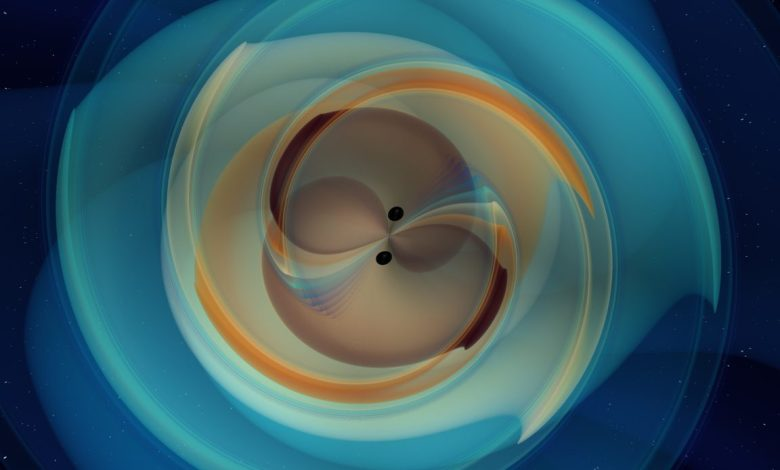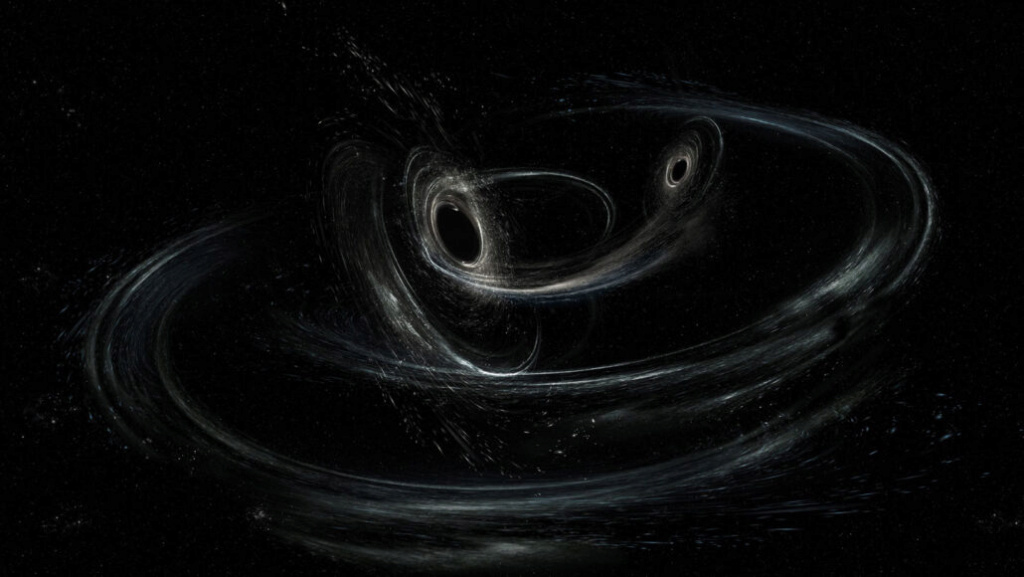Researchers monitor the merging of two black holes in an attempt to understand the effect of gravitational waves
Gravitational waves gave one of the newly formed black holes a high burst speed. A new black hole formed from the merger of two black holes, and then it traveled at a high speed of 5 million kilometers per hour.
It turns out that these waves are emitted by the two black holes when they spin around each other and before they merge, and these waves push the new black hole formed to move away into space at a maximum speed.
This is what scientists recently noticed and stated in the research published in Physical Review Letters that the speed with which the new black hole was launched is very large and is only 200 times less than the speed of light.
It turns out that these gravitational waves that pushed the black hole out are ripples in the fabric of space-time, usually from any two black holes spinning around each other in an effort to merge.
These emitted waves work to stretch and compress the surrounding space, and if these waves are emitted in one direction towards the universe, this will lead to the rebound of the black hole resulting from the union of the two holes in the opposite direction.”
"The process is very similar to the recoil of a gun after the bullet is fired," said astrophysicist Vijay Varma of the Max Planck Institute for Gravitational Physics in Potsdam, Germany.
In this regard, the gravitational wave observatories LIGO and Virgo in the United States and America received gravitational waves when they reached Earth on January 29, 2020.
These waves revealed facts and details about the process of merging the two holes, and indicated the possibility of a great motive force experienced by the two holes when they rotated around each other; As one precedes the other within the orbital spindles paths.
As they rapidly rotate around each other, the plane in which they are orbiting also oscillates, causing one to precede the other, which increases the resulting thrust—and consequently the rebound—when they merge.
Keen to get as much information as possible about the subject, Varma and his colleagues sifted through the data further to verify that the merger's black hole had been expelled far from where it formed.
Simulation of Merger of Two Black Holes and Gravitational Radiation
With this in mind, the researchers compared their data with various forms of expected black hole mergers, created based on computer simulations capable of solving equations of general relativity (Einstein's theory of gravity).
As a result, the bounce was large, and the researchers discovered that the most likely possibility of a black hole ejection from the place of its formation to the edge of the universe.
Scientists believe that globular clusters - a dense collection of stars and black holes - are one of the sites that black holes share and merge together.
According to the team's studies, the probability of a black hole forming within the assembly after being subjected to the thrust force is only 0.5%. In other types of dense clusters known as nuclear star clusters, the proportion reached 8%.
In addition to the above, the researchers found that the black hole's big eruption is likely to lead to major repercussions.
The observatories LIGO and Virgo identified the merger of black holes of large stellar masses that formed after a star exploded and turned into a supernova, and then the star collapsed into a black hole.
Scientists want to know whether black holes that share globular clusters can recombine, ie do these black holes undergo multiple rounds of merging with other holes?
If this possibility exists, it explains the sudden appearance of many of the large black holes previously seen in mergers.
But if black holes are ejected out of the place where they formed, the probability of multiple merging will decrease.
"This driving force is an important component of understanding how supermassive black holes form," Varma says.
Previously, astronomers found evidence of the gravitational wave thrust of massive black holes and found that stellar masses of the greatest size are located at the centers of galaxies.
Scientists' conclusions had previously been based on observing light rather than gravitational waves. "The easiest way to explain events is the easiest way to explain events," said astrophysicist Manuela Campanile of the Rochester Institute of Technology in New York, who was not involved in the recent study.
Recently, data from both the LIGO and Virgo observatories revealed some facts about black holes that were subjected to small thrust forces.
Black Holes and Gravitational Waves: Using Einstein's Legacy to Explore the Universe
The new study is the first of its kind to demonstrate the use of gravitational waves to detect a black hole that has received a lot of momentum, but according to Campanilli, it's not new. "It's really amazing that someone can see what your scientific studies have already predicted," she says.
Source: Science News Translated by: ibelieveinsci
https://shahbapress.net/archives/24736?fbclid=IwAR0Gxx_MTCdRbrl59u9VJjc4lfiWq6WxlWd_rQj-CDeauW_zeXuSpHkP2DU



